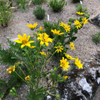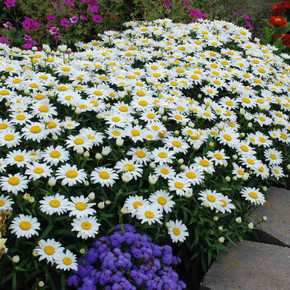
Engelmannia peristenia - ENGELMANN'S DAISY
Engelmannia peristenia is a tough perennial with nicely semi-evergreen to evergreen leaves and yellow daisy-like flowers starting in early to late summer. It blooms for an extremely long time. It is tolerant of drought, heat, and humidity, as well as resistant to deer and rabbits. It attracts bees, butterflies, and hummingbirds.
It grows best in leaner soil and full sun; otherwise the plants can flop, although they can easily be cut back, which causes shorter, stronger stems and supports more blooming. In any case, some drainage is always beneficial. After it's finished flowering, you can cut it back for new flush of blooms. It can re-seed where it's happy.
Best for sunny flower beds with drained soils, rocky soil, sandy soil, dry and hot spots, xeriscapes, water-wise plantings, or a pollinator or hummingbird garden. Easy to grow perennial - just provide sun and some drainage!
Picture copyright: US Perennials nursery
Blooming Time: May until frost
Size: up to 24-36" tall x 18" wide
USDA Zones: 4 to 9
Culture: full sun, prefers some drainage (grows well in rocky, sandy, shallower or poor soils, but is adaptable to most soil types, including clay)
Moisture Needs: medium-dry to dry
Origin: native wildflower to South Dakota, Nebraska, Kansas, Colorado, New Mexico, Texas, Oklahoma, Missouri and Arkansas, where it's quite common and can be seen growing along roads, on dry slopes, and in poor and lean soils (USDA distribution map)
Deer/Rabbit Resistant: yes / yes
Attracts Butterflies or Pollinators: yes / yes
Attracts Hummingbirds: yes
Pot Size: square 3.5" x 5" deep pot

Engelmannia peristenia - ENGELMANN'S DAISY
Engelmannia peristenia is a tough perennial with nicely semi-evergreen to evergreen leaves and yellow daisy-like flowers starting in early to late summer. It blooms for an extremely long time. It is tolerant of drought, heat, and humidity, as well as resistant to deer and rabbits. It attracts bees, butterflies, and hummingbirds.
It grows best in leaner soil and full sun; otherwise the plants can flop, although they can easily be cut back, which causes shorter, stronger stems and supports more blooming. In any case, some drainage is always beneficial. After it's finished flowering, you can cut it back for new flush of blooms. It can re-seed where it's happy.
Best for sunny flower beds with drained soils, rocky soil, sandy soil, dry and hot spots, xeriscapes, water-wise plantings, or a pollinator or hummingbird garden. Easy to grow perennial - just provide sun and some drainage!
Picture copyright: US Perennials nursery
Blooming Time: May until frost
Size: up to 24-36" tall x 18" wide
USDA Zones: 4 to 9
Culture: full sun, prefers some drainage (grows well in rocky, sandy, shallower or poor soils, but is adaptable to most soil types, including clay)
Moisture Needs: medium-dry to dry
Origin: native wildflower to South Dakota, Nebraska, Kansas, Colorado, New Mexico, Texas, Oklahoma, Missouri and Arkansas, where it's quite common and can be seen growing along roads, on dry slopes, and in poor and lean soils (USDA distribution map)
Deer/Rabbit Resistant: yes / yes
Attracts Butterflies or Pollinators: yes / yes
Attracts Hummingbirds: yes
Pot Size: square 3.5" x 5" deep pot
Customer Reviews
-
An interesting, underused perennial
Where I grow this (Central Arkansas) Englemann's Daisy flowers from about the beginning of May until close to the end of June (depending on the weather). Here, the foliage tends to fade in the hottest part of the year - but it reappears reliably in the fall (and has noticeable foliage over the winter). It's an excellent plant as part of a succession - where other things will replace it later in the season. Super easy/carefree plant.






